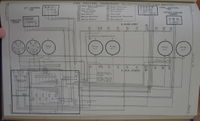Difference between revisions of "H.M.S. Agincourt (1913)"
| Line 292: | Line 292: | ||
Dates of appointment are provided when known. | Dates of appointment are provided when known. | ||
<div name=fredbot:officeCapt otitle="Captain of H.M.S. ''Agincourt''">{{TenureListBegin|Captain of {{UK-Agincourt|f=p}}}} | <div name=fredbot:officeCapt otitle="Captain of H.M.S. ''Agincourt''">{{TenureListBegin|Captain of {{UK-Agincourt|f=p}}}} | ||
| − | {{Tenure|rank={{CaptRN}}|name=Douglas Romilly Lothian Nicholson|nick=Douglas R. L. Nicholson|appt=7 August, 1914<ref>Nicholson Service Record. {{TNA|ADM 196/42.}} f. 457.</ref>|end= | + | {{Tenure|rank={{CaptRN}}|name=Douglas Romilly Lothian Nicholson|nick=Douglas R. L. Nicholson|appt=7 August, 1914<ref>Nicholson Service Record. {{TNA|ADM 196/42.}} f. 457.</ref>|end=10 January, 1916<ref>Nicholson Service Record. {{TNA|ADM 196/42.}} f. 457.</ref>|precBy=New Command}} |
{{Tenure|rank=Captain|name=Henry Montagu Doughty|nick=Henry M. Doughty|appt=10 January, 1916{{NLDec16|p. 391''d''}}<ref>Doughty Service Record. {{TNA|ADM 196/43.|}} f. 50.</ref>|end=11 April, 1917<ref>Doughty Service Record. {{TNA|ADM 196/43.|}} f. 50.</ref>}} | {{Tenure|rank=Captain|name=Henry Montagu Doughty|nick=Henry M. Doughty|appt=10 January, 1916{{NLDec16|p. 391''d''}}<ref>Doughty Service Record. {{TNA|ADM 196/43.|}} f. 50.</ref>|end=11 April, 1917<ref>Doughty Service Record. {{TNA|ADM 196/43.|}} f. 50.</ref>}} | ||
{{Tenure|rank=Captain|name=Henry Lancelot Mawbey|nick=Henry L. Mawbey|appt=11 April, 1917{{NLFeb19|p. 725}}<ref>Mawbey Service Record. {{TNA|ADM 196/43.}} f. 85.</ref>|end=19 February, 1919<ref>Mawbey Service Record. {{TNA|ADM 196/43.}} f. 85.</ref>}} | {{Tenure|rank=Captain|name=Henry Lancelot Mawbey|nick=Henry L. Mawbey|appt=11 April, 1917{{NLFeb19|p. 725}}<ref>Mawbey Service Record. {{TNA|ADM 196/43.}} f. 85.</ref>|end=19 February, 1919<ref>Mawbey Service Record. {{TNA|ADM 196/43.}} f. 85.</ref>}} | ||
Revision as of 16:32, 11 March 2015
| H.M.S. Agincourt (1913) | |
|---|---|
| Pendant Number: | 53 (Aug 1914) 04 (Jan 1918) 09 (Apr 1918)[1] |
| Builder: | Armstrong[2] |
| Job Number: | 690A |
| Laid down: | 14 Sep, 1911 |
| Launched: | 22 Jan, 1913[3] |
| Requisitioned: | Aug, 1914[4] |
| Commissioned: | 7 Aug, 1914 |
| Sold: | 19 Dec, 1922[5] |
| Fate: | Scrapped |
H.M.S. Agincourt was a dreadnought battle built in England for Brazil as Rio de Janeiro featuring seven twin 12-in turrets on her centre line. She was requisitioned for use in the Royal Navy and fought as part of the Grand Fleet.
Launch
Rio de Janeiro was launched on 22 January, 1913 by Mme. Huet de Bacellar, wife of Admiral Huet de Bacellar, the Chief of the Brazilian Naval Commission. The Brazilian Minister was represented by Senhor A. Guerre Duval.
Seizure
On 31 July, 1914, Churchill wrote to the King that:
I have taken the responsibility of forbidding the departure of the Turkish battleship Osman (late Rio) with the Prime Minister's approval. If war comes she will be called - and shd Your Majesty approve - the Agincourt & will convey Sir Henry Jackson to reinforce, & at the regular date assume command of, the Mediterranean.[6]
Service
On 17 August Agincourt was ordered to leave Newcastle as soon as possible and proceed to the vicinity of Loch Ewe for gunnery and torpedo practice.[7]
In November Vice-Admiral Sir David Beatty, whose First Battle Cruiser Squadron had been weakened by the need to hunt down the German East Asia Squadron following the Battle of Coronel, requested that Agincourt be attached to his command, which request Admiral Sir John Jellicoe, commanding the Grand Fleet, felt unable to comply with owing to "the "AGINCOURT'S" comparatively low speed and rather poor radius of action makes her unsuitable. Her oil fuel installation is practically of very little use."[8]
On 24 October, 1915, Agincourt transferred from the Fourth Battle Squadron to the First Battle Squadron, exchanging places with Superb.[9]
Jutland
- Main article: H.M.S. Agincourt at the Battle of Jutland
Armament
Turret Designation
It is often stated that the seven turrets were named after days of the week rather than the letters usually used in the Royal Navy.[10] They may have been known by crew members by such a designation, but in official literature the turrets were numbered 1 to 7.[11] John Roberts has informed the editors that the as-fitted plans of Agincourt from 1918 reflect this usage.[12]
Main Battery
This section is sourced in The Sight Manual, 1916.[13]
The fourteen 12-in guns were Mark XIII mounted in "12-in special" turrets capable of 14 degrees elevation and 5 degrees depression.
The gun sights were gear-worked, telescopic sights with a range gearing constant of 50 and limited to 13.5 degrees elevation, but 6 degree super-elevation prisms would have been provided by 1916.
The deflection gearing constant was 70, with 1 knot equalling 2.56 arc minutes, calculated as 2700 fps at 5000 yards. Range drums were provided for 4 CRH projectiles at full charge at 2650 fps, as well as 6-pdr sub-calibre gun and .303-in aiming rifles.
Muzzle velocity was corrected by adjustable pointer between +/- 75 fps. The adjustable temperature scale plate could vary between 60 to 100 degrees Fahrenheit,[Fact Check] and a "C" corrector could alter the ballistic coefficient by at least +/- 15% and possibly 20% as in other sights.[Fact Check]
Drift was corrected by inclining the sight bracket by 2 degrees.
The side position sighting lines were 32 inches above and 45 inches abreast the bore, and the central scopes were 48 inches above and 42 inches abreast.
Secondary Battery
- 6-in guns on Type "E" mountings.[14]
Torpedoes
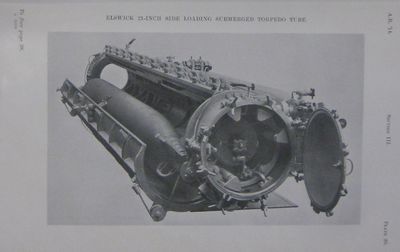
- three Elswick 6.3m (6.5m?)21-in undepressed[Inference] submerged tubes, one at stern and 2 broadside tubes forward bearing 75 (or 71.5[16]) degrees.
Impulse from Elswick H.P. air.[17] At the start of the war, eight Mark II torpedoes intended for Japan and two Mark IIIs intended for Turkey were given to Agincourt, but her Elswick type submerged tubes required the torpedoes be shortened to 6.5m from 6.8m by removing a section at the rear of the head. The modified Mark II torpedoes retained their settings for:[18]
- 41 knots to 1,000 metres
- 41 knots to 2,000 metres (sic)
- 38 knots to 3,500 metres
- 29 knots to 7,000 metres
- 25 knots to 10,000 metres
The Mark III torpedoes were sawn off to 6.35m and were settable to:
- 41 knots to 1,000 metres
- 36 knots to 3,500 metres
- 27 knots to 6,000 metres
The stern tube's torpedo outfit of 21-in Weymouth Mark III torpedoes was to be re-ranged for 21-knot running for use by the broadside batteries of Agincourt and Erin, sometime during or after 1916.[19]
By 1917-1918, a number of common Torpedo Control equipment packages were to be provided to those ships not already sporting them. Those for the 21-in torpedo ships follow.
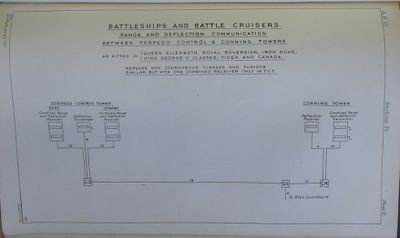
The data instruments to be wired between C.T. and T.C.T. to share range, order and deflection data provided a single deflection transmitter in the T.C.T. so that the results of the torpedo plot to be sent to the single deflection receiver in the C.T. for the information of the Torpedo Control Officer. Conversely, a combined range and deflection transmitter forward allowed the T.C.O. to send back the deflection and intended firing range to the secondary T.C.O. in the T.C.T..[21]
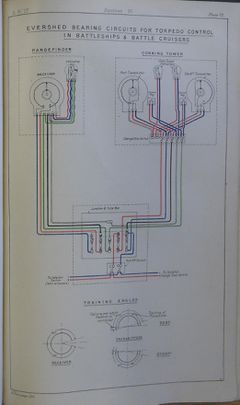
The 21-in torpedo ships were also to be provided with Evershed transmitters in the C.T. and a receiver at the torpedo rangefinder in the T.C.T. in order to ensure that it was obtaining data on the intended target. Limited "slit space" in the C.T. required that the customary binocular-based transmitters be foregone in favour of placing the transmitter on or below the floorboards and to drive it by a shaft from a Torpedo Deflection Sight Mark IV. A control key on the transmitter allowed it to indicate when it was controlling the remote rangefinder or not.[23]
Finally under the 1917-1918 mandate, sufficient instruments were to be provided to permit the Fore Bridge to communicate with the tubes.[24]
Fire Control
Although Agincourt was largely stiffed in the Handbook for Fire Control Instruments, 1914, her general arrangement of instruments and wiring is spelled out in rich detail in Annual Report of the Torpedo School, 1915. It is important to note that she received significant modifications upon being taken up by the Royal Navy. Primary amongst these changes were the removal of the aft control top, fitting of a 6-in TS forward, and abandoning the Torpedo Control Tower as an alternative control position.[25]
Rangefinders
As completed, she had a rangefinder on her foremast and one in each of her seven turrets.[26] A 9-ft rangefinder was added in place of searchlights from her foremast in 1917-1918 and a high angle rangefinder (likely a 2m F.T. 29) was added over the fore control top in 1918.[27]
Evershed Bearing Indicators
By 1915, Agincourt had Evershed equipment of some sort installed to support her 6-in battery. One must presume that this means she also had Evershed equipment for her main battery.[28]
In 1917, it was approved that capital ships of Dreadnought class and later should have Evershed equipment added to their C.T., able to communicate with either the fore top or the G.C.T.. In Agincourt, this might be interpreted as meaning her spotting tower. If there were not enough room in the C.T., a bearing plate with open sights and 6-power binoculars would be added to the C.T..[29]
Also in 1917, it was decided that all directors were to be fitted with receivers and, "as far as possible", ships were to have fore top, G.C.T. and controlling turrets fitted to transmit as well as receive, though this was noted as being impossible in some earlier ships. While it would have been nice to have the C.T. able to transmit bearings to the 6-in guns, it was decided not to do this for reasons of space.[30]
Mechanical Aid-to-Spotter
At some point, Agincourt was equipped with a pair of Mechanical Aid-to-Spotter Mark Is, one on each side of the foretop, keyed off the Evershed rack on the director. As the need for such gear was apparently first identified in early 1916, it seems likely that these installations were effected well after Jutland.[31]
In 1917, it was decided that these should all have mechanical links from the director and pointers indicating the aloft Evershed's bearing, and that the G.C.T. should have a set, as well, though it is not clear that this later equipment was provided.[32]
Gunnery Control
The control arrangements were as follows.[33]
Control Positions
For the 12-in guns:
- Fore top
- Spotting tower (after end of conning tower)
- No. 2 turret
- No. 6 turret
The torpedo director tower was originally designated an alternative control position, but during or before 1915, it was deemed fit to remove this function and make it a torpedo control position instead.
The 6-in guns were originally to be controlled from sighting hoods created for the purpose, but 12-in blast made them untenable. They were removed by 1915 and a new control position made in the fore lower top.
Control Groups
Around 1915, her 6-in battery's use was rejiggered from its original conception. The six 6-in guns in the upper deck and the 3-in guns were disconnected from the fire control network in light of their lack of armour protection. It was envisioned that they would henceforth be employed solely for anti-submarine defence and not used in any way as part of the 6-in battery in action; it was thought that damage to the wiring would be a certainty. Henceforth, the seven 6-in guns remaining on each broadside on the main deck would form 2 groups:[34]
- guns 1-4
- guns 5-7
Directors
Main Battery
Agincourt's main battery director system was installed too late to assist her at Jutland, though the wiring for its installation had been completed by 1915.[35]
Sometime after Jutland, Agincourt was fitted with a cam-type, tripod-mounted director in a light aloft tower on the foremast along with directing guns in turrets 2 & 6.[36] The battery could be divided into forward (turrets 1-4) and aft (turrets 5-7) groups for split director firing, with a 5 position C.O.S. in the T.S. offering these options:[37]
- All turrets on aloft director
- All turrets on directing gun in turret 2
- All turrets on directing gun in turret 6
- Forward group on aloft director, aft group on directing gun in turret 6
- Forward group on directing gun in turret 2, aft group on directing gun in turret 6
The turret Elevation Receivers were pattern number H. 2, capable of 13.5 degrees elevation. The Training Receivers were the single dial type, pattern number 10.[38]
Secondary Battery
The 6-in broadside guns were supported by a pair of pedestal-mounted directors situated to port and starboard on the forward superstructure.[39] Ships with broadside batteries and directors featured no options for switching guns from the director serving their broadside.
The Elevation Receivers on the guns were 6-in P. VIII Type with electrical tilt correctors, Pattern F.C. 4, capable of 13 degrees elevation. The Training Receivers were of the small type, pattern number 17 on guns 1 to 3 and pattern 18 on guns 4 to 10[40]
Torpedo Control
At some point, Agincourt was equipped with a Torpedo Control Plotting Instrument Mark I, as by the end of 1917 it was proposed that hers should be removed to evaluate proposed changes to the optics and plotting portions of the device.[41]
Transmitting Stations
It appears that Agincourt was constructed with just a single T.S. aft, just to the port side of the barbette of No 6. turret, and that this served her 12-in and 6-in guns entirely. When the 6-in Evershed system was installed sometime during or before 1915, the crowding was untenable, and so a second T.S. was created forward, split into two halves for port and starboard 6-in control.[42]
The aft T.S. contained 2 change-over switches and a group switch to route outbound transmitters. The group switch was fed by seven Combined Range, Orders and Deflection Transmitters and provided outputs to the 7 turrets. A 42 pole C.O.S. routed bearing and rate indications, and a 54 pole 2-way C.O.S. handled salvos, special orders, and speed.
The aft T.S. contained two alternators to provide power, any one of which could be connected up although both could be kept running. In 1915, the same T.S. also contained the selector switch for the 12-in Evershed gear and ready for the C.O.S. for the director system when installed.
Dreyer Table
Agincourt was fitted with a Mark I Dreyer Table.[43]
She also had 2[Inference] Dreyer Turret Control Tables in her control position turrets, 2 & 6[Inference].[44]
Fire Control Instruments
In 1915, the various positions were equipped as follows.[45] It seems clear that the majority of this equipment is Barr and Stroud.
Fore upper control top:
- Combined Rate, Order, Deflection (R.O.D.) Transmitter
- Bearing Transmitter
- Deflection Transmitter
This goes to "old 6-in control cabinet", presumably in the 12-in TS and thus was no longer used - Rate Transmitter
- Repeat R.O.D. receiver from No. 2 turret
- Speed Receiver
- A salvo fire gong push originally located here was removed to the T.S. during or before 1915.
- Six phones:
- Three to aft T.S.
- One "director tower" (torpedo director tower?)
- One to upper conning tower
- One to turrets via selector switch: 1 & 2 or 3 & 4 or 5-7
- Three voicepipes:
- One to fore bridge
- One to fore lower control top
- One to conning tower
After control top had been removed and its gear relocated, much of it to new 6-in fore T.S..
Director tower (I think this means the aft torpedo control tower):
- Bearing transmitter
- R.O.D. receiver from No. 5 turret
- Deflection Transmitter
- Three phones:
- One to aft T.S.
- One to fore control top
- One to conning tower
Spotting tower:
- R.O.D. transmitter
- Special order transmitter
- Repeat R.O.D. receiver from No. 2 turret
- Four phones:
- Two to aft T.S.
- One to torpedo control tower
- One to Fore control tower
Upper conning tower:
- Speed transmitter
- Four phones:
- Two to aft T.S.
- One to torpedo control tower
- One to Fore control tower
- Three voicepipes:
- One to fore T.S. (forked P&S at bottom)
- One to lower C.T.
- One to fore upper control top
Lower conning tower:
- voicepipes:
- One to upper C.T.
- One to fore T.S., port battery side
- One to fore T.S., starboard battery side
12-in Turrets:
- Four R.O.D. receivers (near sighting hoods and at officer's position)
- Special order receiver
- Salvo gong
- One Graham's phone to aft T.S.
- One voicepipe to fore T.S. (forked into turrets 1 and 2 only)
- One voicepipe to Lower Mess Deck amidships (forked into turrets 3 and 4 only)
12-in turrets Nos. 2 and 6:
- R.O.D. transmitter to aft T.S.
- A second Graham's phone to aft T.S.
Fore lower control top (6-in control position):
- R.O.D. transmitter (to R.O.D. on both sides of fore 6-in T.S.)
Aft 12-in T.S.:
- Rate transmitter to fore T.S. (working 2 receivers there)
- Two Siemens switchboards:
- Four Siemens phones:
- One to former officer's sighting hood, port 6-in
- One to former officer's sighting hood, starboard 6-in
- One control phone in port 6-in switchboard
- One control phone in starboard 6-in switchboard
- Two Graham navyphones:
- One to fore T.S., port battery side
- One to fore T.S., starboard battery side
- One voicepipe to turrets 5-7
Fore 6-in T.S., port battery side:
- R.O.D. receiver
- Rate receiver (from transmitter in after 12-in T.S.)
- R.O.D. transmitter
- Fire gong push with a switch that can remove last three 6-in guns
- One Graham navyphone to aft T.S.
- One Siemens phone to address up to 3 guns switched via aft T.S.
- Five voiceipes:
- One to fore lower control top
- One to upper C.T. (forked with starboard side of T.S.)
- One to lower C.T.
- One to number 1 gun in own battery
- One to 12-in turrets Nos. 1 & 2
Fore 6-in T.S., starboard battery side is as above, plus a Graham navyphone to the voicepipe on Lower Mess Deck Amidships under 12-in turrets 3 & 4.
6-in guns:
- One D.O.R. receiver (possibly removed from guns 8-10 by 1915?)
- One special order receiver (guns 4 & 9 only)
- One Siemens telephone (removed from guns 8-10) to 6-in switchboard in aft T.S.
Captain's Cease Fire Bell (in upper C.T.?): Two pushes were fitted, one for 12-in and a second for 6-in, with separate bells for each being in the original T.S. aft. Upon creation of the 6-in T.S. forward, the aft T.S. retained its 6-in case fire bell and the 6-in T.S. was added to this circuit.
By mid-1918, it was approved to fit Pattern 3331 Navyphones with loud-sounding bells in the auxiliary machinery compartments of Lion and Orion classes and later where existing navyphones have proven ineffective.[46]
Alterations
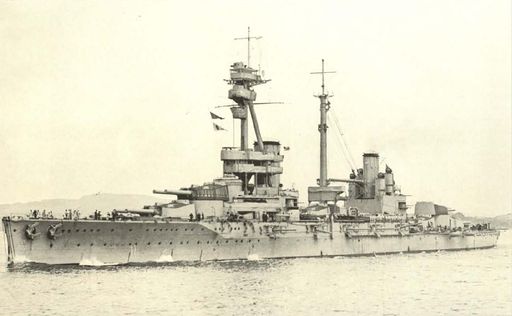
Although in November, 1914 Agincourt was specified as a ship to receive a director and this task received special emphasis in mid 1915,[47] she fought at the Battle of Jutland without a director[48] and was not fitted until some time in June-July, 1916 while at Portsmouth Royal Dockyard.[Citation needed]
As of February, 1916, Agincourt had not yet been fitted with a Dreyer Fire Control Table.[49] It is therefore possible that she was not so fitted at the Battle of Jutland,[50] but it as yet unconfirmed. As of June, 1918, she had been fitted with a Mark I fire control table.[51]
At some point, Agincourt was equipped with two Mechanical Aid-to-Spotter Mark Is, one on each side of the foretop, keyed off the Evershed rack on the director. As the need for such gear was apparently first identified in early 1916, it seems likely that these installations were effected well after Jutland.[52]
Agincourt received directors for her secondary battery in July, 1918.[53]
Rangefinders
In 1918, it was proposed that she should add a 9-foot rangefinder for torpedo control low down before the fore mast on the navigating bridge, although the then-existing 9-foot instrument in the lower top for the 6-inch guns had been offered as available for torpedo control if desired since 1915.[54]
Torpedoes
At the start of the war, all 21-in Weymouth torpedoes in England were purchased: eight Mark II models intended for Japan and two Mark III intended for Turkey were given to Agincourt, but her Elswick type submerged tubes required the torpedoes be shortened to 6.5m from 6.8m by removing a section at the rear of the head.[55]
Captains
Dates of appointment are provided when known.
- Captain Douglas R. L. Nicholson, 7 August, 1914[56] – 10 January, 1916[57]
- Captain Henry M. Doughty, 10 January, 1916[58][59] – 11 April, 1917[60]
- Captain Henry L. Mawbey, 11 April, 1917[61][62] – 19 February, 1919[63]
- Captain R. Cecil Hamilton, 19 February, 1919[64]
- Commander Vincent L. Bowring, 25 June, 1919[65]
See Also
Footnotes
- ↑ Dittmar; Colledge. British Warships 1914–1919. p. 33.
- ↑ Conway's All the World's Fighting Ships 1906–1921. p. 37.
- ↑ Dittmar; Colledge. British Warships 1914–1919. p. 33.
- ↑ Dittmar; Colledge. British Warships 1914–1919. p. 33.
- ↑ Dittmar; Colledge. British Warships 1914–1919. p. 33.
- ↑ Winston S. Churchill. Companion Volume II Part 3. p. 1992.
- ↑ "Grand Fleet Operations - Narrative of Events." Jellicoe Papers. British Library. Add MS. 48995. f. 40.
- ↑ Jellicoe to Admiralty. Letter 473/H.F.0010 of 19 November, 1914. M.03873/14. The National Archives. ADM 137/995.
- ↑ Jellicoe Papers. British Library. Add MS 49000. f. 266.
- ↑ Conway's. p. 37.
Parkes. p. 603.
Hore. p. 147.
Sturton. p. 81. - ↑ The Director Firing Handbook. p. 88.
- ↑ Email to Simon Harley of 31 December, 2011. Mr. Harley is grateful to Mr. Roberts for generously sharing this information, and for pointing him to the correct page of his copy of The Director Firing Handbook, 1917.
- ↑ The Sight Manual. 1916. pp. 41, 106, 108-109.
- ↑ The Director Firing Handbook. p. 144.
- ↑ Annual Report of the Torpedo School, 1914. Plate 20.
- ↑ Annual Report of the Torpedo School, 1918. p. 51.
- ↑ Annual Report of the Torpedo School, 1915. p. 36.
- ↑ Annual Report of the Torpedo School, 1914. pp. 10-11.
- ↑ Annual Report of the Torpedo School, 1916. p. 36. (T.O. 168/1916).
- ↑ Annual Report of the Torpedo School, 1917. Plate 71.
- ↑ Annual Report of the Torpedo School, 1917. p. 208. (T.O. 29/17.).
- ↑ Annual Report of the Torpedo School, 1917. Plate 72.
- ↑ Annual Report of the Torpedo School, 1917. p. 208. (C.I.O. 4585/17.) .
- ↑ Annual Report of the Torpedo School, 1917. p. 208. (C.I.O. 1644/17, 3706/17.).
- ↑ Annual Report of the Torpedo School, 1915. p. 223, Plate 111.
- ↑ Burt. British Battleships of World War One. p. 245.
- ↑ Burt. British Battleships of World War One. p. 250.
- ↑ Annual Report of the Torpedo School, 1915. p. 226.
- ↑ Annual Report of the Torpedo School, 1917. p. 230.
- ↑ Annual Report of the Torpedo School, 1917. p. 230.
- ↑ The Technical History and Index, Vol. 3, Part 23. pp. 25-6.
- ↑ Annual Report of the Torpedo School, 1917. p. 230.
- ↑ Annual Report of the Torpedo School, 1915. pp. 223-4.
- ↑ Annual Report of the Torpedo School, 1915. pp. 223-4.
- ↑ Annual Report of the Torpedo School, 1915. pp. 226.
- ↑ The Director Firing Handbook. pp. 88-9, 142.
- ↑ The Director Firing Handbook. p. 88-9.
- ↑ The Director Firing Handbook. pp. 144, 146.
- ↑ The Director Firing Handbook. pp. 143.
- ↑ The Director Firing Handbook. p. 144, 146.
- ↑ Annual Report of the Torpedo School, 1917. p. 195. (A.L.G 5422/17.).
- ↑ Annual Report of the Torpedo School, 1915. pp. 223-4, 226.
- ↑ Handbook of Captain F. C. Dreyer's Fire Control Tables, 1918. p. 3.
- ↑ Handbook of Captain F. C. Dreyer's Fire Control Tables, 1918. p. 3.
- ↑ Annual Report of the Torpedo School, 1915. pp. 223-6 and Plate 111.
- ↑ Annual Report of the Torpedo School, 1917. p. 233.
- ↑ The Technical History and Index: Fire Control in H.M. Ships. p. 10.
- ↑ The Technical History and Index: Fire Control in H.M. Ships. p. 11.
- ↑ Schliehauf. The Dumaresq and the Dreyer Part II. pp. 186, 201, citing The National Archives. T 173/204.
- ↑ Friedman. p. 46.
- ↑ Handbook of Captain F. C. Dreyer's Fire Control Tables. p. 3.
- ↑ The Technical History and Index, Vol. 3, Part 23. pp. 25-6.
- ↑ The Technical History and Index: Fire Control in H.M. Ships. p. 16.
- ↑ Annual Report of the Torpedo School, 1918. p. 178. (G. 8256/15).
- ↑ ARTS 1914, pp. 8-11.
- ↑ Nicholson Service Record. The National Archives. ADM 196/42. f. 457.
- ↑ Nicholson Service Record. The National Archives. ADM 196/42. f. 457.
- ↑ The Navy List. (December, 1916). p. 391d.
- ↑ Doughty Service Record. The National Archives. ADM 196/43. f. 50.
- ↑ Doughty Service Record. The National Archives. ADM 196/43. f. 50.
- ↑ The Navy List. (February, 1919). p. 725.
- ↑ Mawbey Service Record. The National Archives. ADM 196/43. f. 85.
- ↑ Mawbey Service Record. The National Archives. ADM 196/43. f. 85.
- ↑ The Navy List. (May, 1919). p. 725.
- ↑ The Navy List. (September, 1919). p. 725.
Bibliography
- Admiralty, Gunnery Branch (1917). The Director Firing Handbook. O.U. 6125 (late C.B. 1259). Copy No. 322 at The National Archives. ADM 186/227.
- Admiralty, Gunnery Branch (1918). Handbook of Captain F. C. Dreyer's Fire Control Tables, 1918. C.B. 1456. Copy No. 10 at Admiralty Library, Portsmouth, United Kingdom.
- Admiralty, Technical History Section (1919). The Technical History and Index: Fire Control in H.M. Ships. Vol. 3, Part 23. C.B. 1515 (23) now O.U. 6171/14. At The National Archives. ADM 275/19.
- Brooks, John (2005). Dreadnought Gunnery and the Battle of Jutland: The Question of Fire Control. Oxon: Routledge. ISBN 0714657026. (on Amazon.com and Amazon.co.uk).
- Friedman, Norman (2008). Naval Firepower: Battleship Guns and Gunnery in the Dreadnought Era. Barnsley: Seaforth Publishing. (on Amazon.com and Amazon.co.uk).
- Gray, Randal (editor) (1985). Conway's All the World's Fighting Ships 1906–1921. London: Conway Maritime Press. (on Amazon.com and Amazon.co.uk).
- H.M.S. Vernon. (Jan 1916) Annual Report of the Torpedo School, 1915. C.B. 1166. Copy 1025 at The National Archives. ADM 189/35.
- Hore, Peter (2005). Battleships. London: Lorenz Books. ISBN 0-7548-1407-6.
- Parkes, O.B.E., Ass.I.N.A., Dr. Oscar (1990). British Battleships 1860–1950. London: Pen & Sword Ltd. ISBN 0850526043. (on Bookfinder.com).
- Preston, Antony in Sturton, Ian. ed. (1996). All the World's Fighting Ships, 1906 to the Present. London: Conway Maritime Press. ISBN 0-85177-691-4.
- Roberts, John (1997). Battlecruisers. London: Chatham Publishing. ISBN 186176006X. Annapolis: Naval Institute Press. ISBN 1557500681. (on Amazon.com and Amazon.co.uk).
- Sumida, Jon Tetsuro (1989). In Defence of Naval Supremacy: Finance, Technology and British Naval Policy, 1889-1914. Winchester, Mass.: Unwin Hyman, Inc.. ISBN 0044451040. (on Amazon.com and Amazon.co.uk).
| Dreadnought H.M.S. Agincourt | |||||||||||||||||||||||||||||||||||||||||||||||||||||||||||||||||||||||||||||||||||||||||||||||||||||||||||||||||||||||
| <– | Iron Duke Class | Battleships (UK) | H.M.S. Erin | –> | |||||||||||||||||||||||||||||||||||||||||||||||||||||||||||||||||||||||||||||||||||||||||||||||||||||||||||||||||||
| Foreign Orders (UK) | H.M.S. Erin | –> | |||||||||||||||||||||||||||||||||||||||||||||||||||||||||||||||||||||||||||||||||||||||||||||||||||||||||||||||||||||
